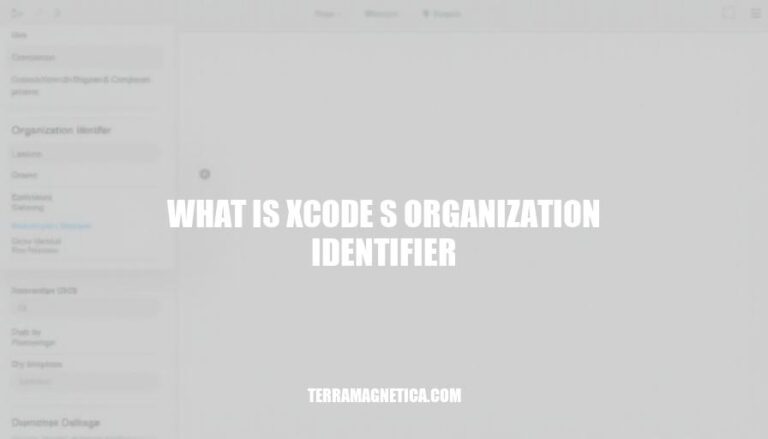The organization identifier in Xcode is a reverse DNS string (like com.example) that uniquely identifies your organization. It’s crucial because it forms part of the bundle identifier for your app, which is used to register your app with Apple and manage its identity across the system. This ensures that your app is uniquely identifiable, preventing conflicts with other apps and maintaining a consistent identity throughout its lifecycle.
Definition of Xcode’s Organization Identifier
The organization identifier in Xcode is a reverse DNS string (e.g., com.example) that uniquely identifies your organization. It forms part of the bundle identifier (CFBundleIdentifier) for your app, ensuring that each app has a unique identifier within the Xcode environment.
Format and Structure
In Xcode, the organization identifier is typically formatted using reverse DNS notation. This means you take your domain name and reverse it. For example, if your domain is example.com, the organization identifier would be com.example. This identifier is then used as a prefix for your app’s bundle identifier, creating a unique identifier for your app, such as com.example.myapp.
Setting Up Xcode’s Organization Identifier
Here are the steps to set up the organization identifier in Xcode when creating a new project:
- Open Xcode and select “Create a new Xcode project”.
- Choose a template for your project (e.g., App, Game).
- Click Next.
- Enter your Product Name.
- In the Organization Identifier field, enter a reverse DNS string (e.g.,
com.example).
- Fill in the Organization Name.
- Click Next and choose a location to save your project.
- Click Create.
That’s it! Your organization identifier is now set up.
Best Practices
Here are some best practices for choosing and managing Xcode’s organization identifier:
- Use Reverse Domain Name Notation: Start with a domain you control, written in reverse (e.g.,
com.example). This ensures global uniqueness.
- Consistency Across Projects: Use the same identifier format for all your projects to maintain consistency.
- Avoid Special Characters: Stick to alphanumeric characters and dots. Avoid spaces, hyphens, and other special characters.
- Reflect Your Organization: If your organization name changes, update the identifier to reflect this, but be aware of the impact on existing apps.
- Document Your Naming Conventions: Keep a record of your naming conventions and share it with your team to ensure everyone follows the same rules.
- Check for Conflicts: Before finalizing, check if the identifier is already in use to avoid conflicts, especially if you plan to distribute your app on the App Store.
Common Issues and Solutions
Here are some common issues developers face with Xcode’s organization identifier and their solutions:
-
Incorrect Format:
- Issue: Using an incorrect format for the organization identifier.
- Solution: Ensure the identifier follows the reverse domain name notation, e.g.,
com.yourcompanyname.
-
Duplicate Identifiers:
- Issue: Using the same organization identifier for different projects.
- Solution: Use unique identifiers for each project to avoid conflicts, unless the projects are part of the same organization.
-
Changing Organization Identifier:
- Issue: Needing to change the organization identifier after project creation.
- Solution: Update the identifier in the project settings and ensure all related files and configurations are updated accordingly.
-
Personal vs. Company Identifier:
- Issue: Confusion between using a personal name or company name.
- Solution: If working solo, use your name (e.g.,
com.yourname). For a company, use the company name (e.g., com.companyname).
-
App Store Submission:
- Issue: Concerns about the identifier during App Store submission.
- Solution: The organization identifier is part of the bundle identifier, which must be unique across the App Store. Ensure it is correctly set before submission.
The Organization Identifier in Xcode
The organization identifier in Xcode is a crucial element that uniquely identifies your organization and forms part of the bundle identifier for your app. It ensures global uniqueness, preventing conflicts with other apps and maintaining a consistent identity throughout an app’s lifecycle.
Setting Up the Organization Identifier
To set up the organization identifier, follow these steps:
- Open Xcode
- Select ‘Create a new Xcode project’
- Choose a template
- Enter your product name
- Fulfill in the Organization Identifier field with a reverse DNS string (e.g., com.example)
Best Practices for Choosing and Managing Xcode’s Organization Identifier
Best practices for choosing and managing Xcode’s organization identifier include:
- Using reverse domain name notation
- Consistency across projects
- Avoiding special characters
- Reflecting organizational changes
- Documenting naming conventions
- Checking for conflicts
Common Issues with Xcode’s Organization Identifier
Common issues developers face with Xcode’s organization identifier include:
- Incorrect format
- Duplicate identifiers
- Changing the identifier after project creation
- Personal vs. company identifier confusion
- App Store submission concerns


